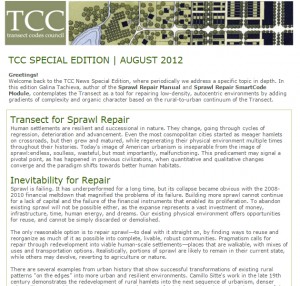Human settlements are resilient and successional in nature. They change, going through cycles of regression, deterioration and advancement. Even the most cosmopolitan cities started as meager hamlets on crossroads, but then grew and matured, while regenerating their physical environment multiple times throughout their histories. Today’s image of American urbanism is inseparable from the image of sprawl: endless, soulless, wasteful, but most importantly, malfunctioning. This predicament may signal a pivotal point, as has happened in previous civilizations, when quantitative and qualitative changes converge and the paradigm shifts towards better human habitats.
Transect for Sprawl Repair
